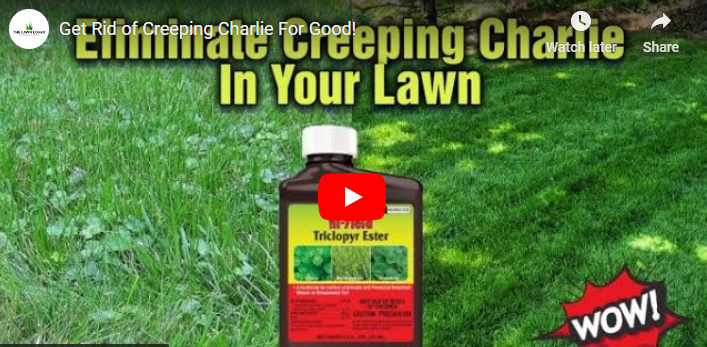Creeping Charlie, also known as ground ivy or Glechoma hederacea, is a persistent weed that can quickly invade and overtake your lawn or garden. Its rapid growth and spreading nature make it a challenging plant to control.
Fortunately, there are effective herbicides available specifically designed to combat creeping Charlie. In this article, we will explore the top 10 best herbicides that can help you eradicate this troublesome weed and regain control over your outdoor spaces.
Top 10 Best Herbicides for Creeping Charlie
Now, let’s explore the top 10 best herbicides specifically formulated for controlling Creeping Charlie. These herbicides have been selected based on their effectiveness, safety, and positive customer feedback. Remember to carefully read and follow the instructions provided by the manufacturer when using these products.
Read Also: Top 15 Best Herbicides for St Augustine Grass
1. Atrazine
Description: This herbicide is specifically designed to target and eliminate Creeping Charlie while sparing surrounding vegetation. It provides effective control and is safe for use in residential areas.
Application Method: Liquid concentrate. Mix with water according to the instructions and apply using a sprayer.
Safety Precautions: Wear protective clothing and follow all safety guidelines mentioned on the product label.
Read Also: Top Best Herbicides For Sugarcane
2. Weed-off:
Description: This herbicide offers a selective approach to control Creeping Charlie without harming desirable plants. It is known for its fast action and long-lasting results.
Application Method: Ready-to-use spray. Simply attach the sprayer nozzle and apply directly to the target areas.
Safety Precautions: Keep children and pets away from the treated areas until the spray has dried.
Read Also: Top 10 Best Herbicides for Clover
3. Uproot
Description: This herbicide combines effectiveness with environmental friendliness. It targets Creeping Charlie while being safe for use around children and pets.
Application Method: Granular formulation. Apply using a broadcast spreader for even coverage.
Safety Precautions: Avoid contact with eyes and skin. Wash hands thoroughly after handling.
Read Also: Top 10 Best Herbicides for Japanese Knotweed
4. ForceUp
Description: This herbicide provides systemic control of Creeping Charlie, ensuring the weed is eliminated from its roots. It is rainfast within a few hours of application.
Application Method: Liquid concentrate. Dilute with water and apply using a sprayer or watering can.
Safety Precautions: Keep away from children and pets. Avoid inhalation and contact with skin.
Read Also: Top 10 Best Herbicides for Thistles
5. Metribuzin, Dacthal, Sethoxydim
Description: This herbicide offers a selective control option for Creeping Charlie while allowing grass to thrive. It works by inhibiting weed growth without harming the surrounding vegetation.
Application Method: Ready-to-use spray. Apply directly to the leaves of Creeping Charlie and avoid spraying desirable plants.
Safety Precautions: Store in a cool, dry place. Keep out of reach of children and pets.
Read Also: The Top 10 Best Herbicides for Poison Ivy
Understanding Creeping Charlie
What is Creeping Charlie?
Creeping Charlie is a low-growing perennial weed with heart-shaped leaves and small bluish-purple flowers. It thrives in shady and moist areas, often spreading rapidly through stolons or creeping stems that root at multiple points. Its aggressive nature can quickly smother desirable plants and grass, leading to an unsightly and unhealthy landscape.
Read Also: Top 10 Best Herbicides For Weed Control
Problems caused by Creeping Charlie
The presence of Creeping Charlie in your lawn or garden can lead to several issues. It competes with other plants for essential nutrients, sunlight, and water, causing the decline of desirable vegetation.
Additionally, its dense mat-like growth makes it difficult for grass to establish and grow, resulting in bare patches and an uneven lawn appearance. Controlling Creeping Charlie is crucial to maintain a healthy and visually appealing landscape.
The Importance of Using Herbicides
Herbicides are valuable tools for managing invasive weeds like Creeping Charlie. They offer an effective and targeted approach to control these troublesome plants without harming the surrounding vegetation. When choosing herbicides for Creeping Charlie, it is important to consider factors such as safety, effectiveness, application method, and residual effects. Let’s explore these factors in detail.
Read Also: Top 10 Best Herbicides for Wild Violets
Safety and Environmental Impact
When selecting herbicides, it’s essential to choose the ones that have minimal impact on human health and the environment. Look for herbicides that are labeled as safe for use in residential areas and follow the instructions provided by the manufacturer regarding application and safety precautions.
Effectiveness
The effectiveness of a herbicide in controlling Creeping Charlie is a critical factor to consider. Look for herbicides that specifically target broadleaf weeds like Creeping Charlie and have a proven track record of success. Reading customer reviews and seeking recommendations from gardening experts can help you determine the effectiveness of different herbicides.
Read Also: Top 10 Best Herbicides for Spurge
Application Method
Consider the application method that best suits your needs and preferences. Herbicides for Creeping Charlie come in various forms, including liquid concentrates, ready-to-use sprays, and granular formulations.
Liquid concentrates require mixing with water before application, while ready-to-use sprays are convenient for quick spot treatments. Granular formulations are ideal for larger areas and can be spread using a broadcast spreader.
Residual Effects
Some herbicides leave residual effects in the soil, which can inhibit the growth of desirable plants or grass. If you plan to reseed or plant new vegetation in the treated area, choose herbicides with minimal residual effects or those labeled as safe for reseeding and planting.
How to Apply Herbicides for Creeping Charlie Control
Now that you have selected the appropriate herbicide for your Creeping Charlie problem, it’s important to know how to apply it correctly for optimal results. Follow these steps to effectively control Creeping Charlie:
Preparing the Area
Before applying herbicides, remove any debris or excessive growth from the target area. This includes mowing the lawn to a suitable height and clearing away any leaves or other obstacles.
Mixing and Diluting the Herbicide
If you’re using a liquid concentrate, carefully measure and mix the herbicide with water according to the instructions provided. Use a clean sprayer or watering can for the mixture.
Applying the Herbicide
Apply the herbicide evenly to the leaves and stems of Creeping Charlie. Be careful not to overspray or allow the herbicide to come into contact with desirable plants. If using a granular formulation, follow the recommended spreader settings for even distribution.
Post-Treatment Care
After application, allow the herbicide to dry or settle according to the instructions provided. Avoid watering the treated area for the specified time to allow the herbicide to work effectively. Monitor the progress of Creeping Charlie and reapply the herbicide if necessary.
Alternative Methods for Creeping Charlie Control
While herbicides are effective in controlling Creeping Charlie, there are alternative methods you can consider:
Manual Removal
Hand-pulling or digging out Creeping Charlie can be effective for small infestations. Ensure you remove as much of the plant and its roots as possible to prevent regrowth. Be diligent in removing all traces of the weed to minimize its spread.
Cultural Practices
Implementing proper lawn care practices can help prevent and control Creeping Charlie. Regular mowing, adequate watering, and appropriate fertilization promote the growth of a healthy lawn, making it more resistant to weed invasion. Ensure your lawn receives sufficient sunlight to discourage the growth of shade-loving weeds like Creeping Charlie.
Natural Remedies
Some natural remedies can be used in combination with herbicides or as standalone treatments. For example, applying a solution of vinegar or boiling water directly to the weed can help kill it. However, these natural remedies may not be as effective as herbicides and may require repeated applications for satisfactory results.
Remember, while alternative methods may provide some level of control, herbicides often offer the most efficient and reliable solution for eliminating Creeping Charlie.
Can I use herbicides for creeping Charlie in my vegetable garden?
It is essential to choose herbicides that are labeled as safe for use in vegetable gardens. Carefully read the product label to ensure it is approved for use in edible crops and follow the instructions provided.
How long does it take for herbicides to eliminate creeping Charlie?
The time it takes for herbicides to eliminate Creeping Charlie can vary depending on the product and the extent of the infestation. Some herbicides provide visible results within a few days, while others may take a few weeks. Read the product label for specific information on the expected timeframe.
Are herbicides harmful to pets?
Herbicides can be toxic to pets if ingested or if they come into direct contact with them. Follow the safety precautions mentioned on the product label, and keep pets away from treated areas until the herbicide has dried or settled.
Can I use herbicides in rainy weather?
Rainy weather can affect the efficacy of herbicides as it may wash away the product before it has a chance to work effectively. It is generally recommended to apply herbicides when rain is not expected for at least 24 to 48 hours.
Is professional assistance necessary for applying herbicides?
While it is possible to apply herbicides on your own, seeking professional assistance can ensure proper application and maximize effectiveness. Professionals have the knowledge and experience to handle herbicides safely and effectively, especially for larger or more complex infestations.
Conclusion
Controlling Creeping Charlie requires a proactive approach to prevent its spread and ensure the health of your lawn or garden. By choosing the right herbicide from the top 10 options mentioned in this article and following proper application techniques, you can effectively eradicate this invasive weed.
Alternative methods such as manual removal and cultural practices can complement herbicide use. Remember to always prioritize safety when using herbicides and follow the instructions provided by the manufacturer.



